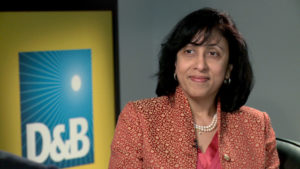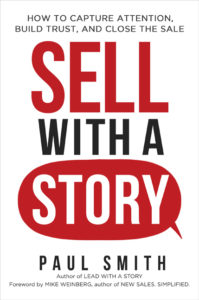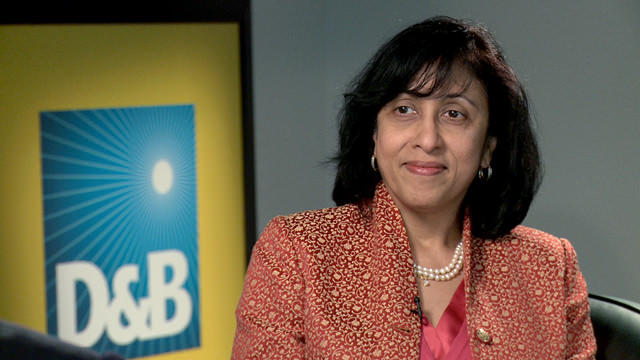Podcast: Play in new window | Download | Embed
Subscribe: RSS
Podcast (lead-with-a-story-podcast-series): Play in new window | Download | Embed
Subscribe: RSS

A leader’s skills, character, and values become clear only when they’re tested in challenging times. Those also happen to be when our skills and character are most likely to grow.
I recently had a chat with Sara Mathew, former Chair and CEO of Dun & Bradstreet, about a couple of harrowing and humbling experiences that put her leadership to the test, and helped her grow as a leader.
It’s more fun to listen to Sara tell these stories herself, which you can do by clicking the play button above. If you prefer to read, below are excerpts from my book Lead with a Story where these stories were originally published.
—
Sara joined Dun & Bradstreet in August 2001, as chief financial officer. Less than a year later, company sales projections were showing a slight decline. But nothing had substantially changed since she’d arrived. So why the drop in the sales forecast? The answer was found in several arcane accounting rules.
One of Sara’s first actions as CFO was to put a new finance team in place so she could be sure the financial reporting was being done by the book. For the complex transactions in their industry, there are several accounting methods to choose from. Knowing which one is best is a complicated affair and depends on the situation. The right answer even changes over time as government regulators make new pronouncements.
Apparently, the methods Sara’s new team was using recognized revenues slower than other methods. Hence, the slight dip in sales. That made Sara curious. She was certain her method was correct. So she had her team look into the methods used in the past. They found the wrong method had been used in several cases. In some of them, the problems went back nearly a decade—not exactly what a new CFO wants to find in her first year.
Sara knew the company would have to restate its financials. That meant reversing all the inappropriate revenues and profits that had been reported in the past—millions of dollars out of its bottom line. And there couldn’t have been a worse time for this to happen. Just months earlier, Enron had filed for the largest bankruptcy in history as a result of fraudulent accounting practices. She went straight to the CEO.
In his office, she remembers the alarm on his face as he responded to the news.
Restatement! Like the Enron restatement?”
“Yes,” she told him. “Like Enron. But in our case, I don’t think there was fraud—just a mistake. I won’t know for sure—or how much money we’re talking about—until we do a thorough investigation.”
“How long will that take?” he asked.
What Sara was thinking was, “Heck, I don’t know. I’ve never done this before.” What she said, however, was, “Our next earnings release is in six weeks. I’ll have it done by then.” At the time, she was unaware that no restatement of this size had ever been completed in less than six months.
As the work began, Sara couldn’t help but worry about the size of the problem. Hopefully, it would be small and inconsequential, and get no negative reaction from Wall Street. Her fear, of course, was that it would be big, and the share price would suffer.
In a situation like this, there are three ways a leader can respond.
- Option one is to ignore the problem. After all, they were using the proper accounting methods now. It’s possible nobody would ever find out about the past errors.
- Option two is to pursue the work on the restatement, but to stop digging when the size of the problem gets too big to go unnoticed on Wall Street. For a company the size of D&B, that number is about $50 million.
- Option three is to keep digging until you find everything, without regard to the size of the problem. Let the chips fall where they may.
Sara chose option three.
Working around the clock, the finance team completed the job in six weeks, as promised. With its next quarterly release, D&B adjusted its income going back 10 years. The grand total was a $150 million charge, with no fraud found. And despite the sizable amount, the stock price held steady. The size of the restatement and the speed with which it was announced left Wall Street certain there were no more skeletons in D&B’s closet. Sara and her team received several accolades and monetary awards for their hard and honest work.
Their actions defined the rules of behavior in the finance department at Dun & Bradstreet. And that’s the main way people learn the rules in any organization — through the stories they hear about other people, both those who broke the rules and suffered the consequences, and those who didn’t and got rewarded.
Sara went on to become CEO and Chair of Dun & Bradstreet. She and others continue to tell this story to help employees understand not just the accounting policy but also the rules of behavior. Doing the right thing is rewarded at D&B. It’s a policy Sara’s confident she won’t need to restate.
But not all was well after the restatement. As Sara soon found out. . .
Getting D&B’s books restated in six weeks left Sara feeling the high of success still early in her tenure as CFO. But that high was short-lived. Once a year, everyone at D&B completes an employee satisfaction survey. Sara had just gotten the results for her department. They were among the worst in the company. Her organization was sending her a clear message about how she had gotten the restatement done. The long hours and unyielding focus had taken its toll. Quickly, she was back in the CEO’s office, and he was not happy. His opening line was, “You’re not leading well, Sara.”
Of course, Sara was disappointed in the survey results. But in the light of what happened with the restatement, it seemed inevitable to her. She assumed the end result justified the means it took to get there. Her response reflected this belief.
You need to make a choice,” she said. “Which do you want—great results, or happy people?”
The CEO’s simple, but profound response was,
Great leaders do both.”
Those words hit Sara like a freight train. It forced her to reflect on her own methods and the impact she can have on others in her urgency to deliver. Like most people, she was aware of her own foibles. She was a strong strategic thinker, and a natural problem solver. But she was also a terrible listener. She was direct—to the point of being blunt. She was tough, demanding, and played to win. If you were on the other side of the table from her, it could be intimidating. But she had assumed that was just part of who she was and a requisite part of how she got things done.
Her boss convinced her otherwise. She decided to have several round-table discussions with her employees to gather direct feedback on the shortcomings of her leadership style. It was a painful, humbling process. But she didn’t just gather the feedback. She actually accepted it and acted on it. Two years later, her employee satisfaction scores were
among the best anywhere.
Sara shares the rest of this story today to teach the value of being a learning leader. Even bosses need to continually learn, whether they are the CFO, CEO, or chairman of the board—all roles Sara has held. If she hadn’t learned the hard lesson she did as CFO, she would have never been given the chance to have the second two.
Use these links to subscribe to this podcast on iTunes or Stitcher, or Podbean.
Source: Lead with a Story: How to Craft Business Narratives that Captivate, Convince, and Inspire, by Paul Smith.
—
 Paul Smith is one of the world’s leading experts on business storytelling. He’s a keynote speaker, storytelling coach, and bestselling author of the books Lead with a Story, Parenting with a Story, and Sell with a Story.
Paul Smith is one of the world’s leading experts on business storytelling. He’s a keynote speaker, storytelling coach, and bestselling author of the books Lead with a Story, Parenting with a Story, and Sell with a Story.


 Connect with him via email here.
Connect with him via email here.
Follow him on Facebook, LinkedIn, Twitter, and Instagram.
Sign up for his newsletter here to get one new story a week delivered to your inbox.

